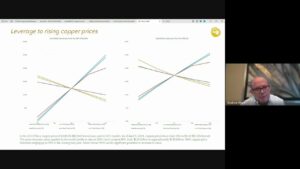Alamos Gold Inc. (TSX:AGI) (“Alamos” or the “Company”) reports financial results for the fourth quarter and year ended December 31, 2010, and provides a review of its outlook for 2011.
Fourth Quarter 2010 Highlights:
- Produced 45,800 ounces of gold, the third highest quarterly production achieved to-date at Mulatos.
- Generated record revenues of $60.8 million from the sale of 44,507 ounces of gold.
- Recognized earnings of $20.1 million ($0.17 per basic share).
- Generated operating cash flows before working capital changes of $35.0 million ($0.30 per basic share).
- Reported cash operating costs of $344 per ounce of gold sold and total cash costs of $413 per ounce of gold sold.
- Paid a semi-annual dividend of 3.5 cents per share.
Full Year 2010 Highlights:
- Produced 156,000 ounces of gold.
- Reported cash operating costs of $302 per ounce of gold sold and total cash costs of $361 per ounce of gold sold.
- Generated revenues of $189.3 million from the sale of 154,343 ounces.
- Recognized record earnings of $65.7 million ($0.57 per basic share).
- Generated operating cash flows before working capital changes of $94.8 million ($0.82 per basic share).
- Initiated a dividend program, paying $7.5 million during the year.
- Acquired the Aði Daði and Kirazli projects in Turkey and completed a positive preliminary economic assessment supporting the advancement of the projects to the preliminary feasibility stage.
- Reported a $12.5 million ($0.11 per basic share) gain on completion of a settlement agreement with Primero Mining in the third quarter.
- Increased cash, cash equivalents, and short-term investment balances amounted to $188.2 million at December 31, 2010.
This press release should be read in conjunction with Alamos’ audited consolidated financial statements for the year ended December 31, 2010 and 2009 and associated Management’s Discussion and Analysis (“MD&A”), which are available from the Company’s website, www.alamosgold.com, in the “Investor Centre” tab in the “Reports and Financial Statements” section, and on SEDAR (www.sedar.com).
Review of Financial Results
Fourth Quarter
The Company reported strong financial results in the fourth quarter of 2010, generating cash flows from operating activities before changes in working capital of $35.0 million ($0.30 per basic share), a 17% increase from $30.0 million ($0.27 per basic share) in the fourth quarter of 2009. After changes in working capital, the Company generated $34.0 million ($0.29 per basic share) in the fourth quarter of 2010, 2% lower than the $34.8 million ($0.32 per basic share) generated in the same period of 2009.
Earnings in the fourth quarter of 2010 were $20.1 million ($0.17 per basic share), consistent with earnings of $20.1 million ($0.18 per basic share) achieved in the same period of 2009. Higher operating margins in the fourth quarter of 2010 were offset by a lower number of ounces sold, higher stock-based compensation expense, and higher corporate and administrative expenses.
Capital expenditures in the fourth quarter of 2010 were $19.8 million, compared with $17.2 million in the same period of last year.
2010
For the full year 2010, the Company generated cash flows from operating activities before changes in working capital of $94.8 million ($0.82 per basic share), an increase of 7% from $88.5 million ($0.83 per basic share) in 2009. After changes in working capital, the Company generated $89.6 million ($0.78 per basic share), 6% lower than the $95.6 million ($0.90 per basic share) generated in 2009.
The Company recognized record earnings of $65.7 million ($0.57 per basic share) in 2010, a 17% increase over earnings of $56.0 million ($0.52 per basic share) in 2009. In 2010, earnings benefited from a $12.5 million one-time gain on completion of a settlement agreement with Primero Mining Corporation (“Primero Mining”). The Primero Mining settlement, coupled with higher realized gold prices, offset a 14% decline in the number of ounces sold and a significant increase in stock-based compensation expense, resulting in improved earnings relative to 2009.
Capital expenditures totalled $60.9 million for the full year 2010, compared with $36.6 million the previous year. The significant increase in capital expenditures on a year-over-year basis is primarily related to the development of the Escondida zone, a crusher expansion, and the construction of a new heap leach pad at the Mulatos Mine. Development activities for the Company’s assets in northwestern Turkey, which were acquired in the first quarter of 2010, also contributed to the increase in capital expenditures.
At December 31, 2010, the Company had $188.2 million in cash, cash equivalents, and short-term investments, an increase of $1.3 million compared to $186.9 million at December 31, 2009. This increase reflects positive cash flows from operations, offset by $40.2 million in cash spent as part of the consideration to acquire the Turkish projects as well as $60.9 million spent on capital projects in Mexico and Turkey.
Alamos continues to have no long-term debt and remains unhedged to future movements in the price of gold.
Key financial metrics for the fourth quarter of 2010 compared to the fourth quarter of 2009, and on a full year basis for 2010 and 2009 are presented at the end of this release in Table 1.
Review of Operational Results
As previously announced on January 17, 2011, the Mulatos Mine produced 156,000 ounces in 2010, a decrease of 13% over gold production of 178,500 ounces in 2009 and slightly below annual production guidance of 160,000 to 175,000 ounces. Gold production was 45,800 ounces in the fourth quarter, the third highest quarterly production achieved to date at Mulatos. Gold production in the fourth quarter of 2010 was 52% higher than the 30,200 ounces produced in the third quarter of 2010, and 5% below the 48,000 ounces produced in the fourth quarter of 2009. The annual decrease in gold production is primarily attributable to adverse weather conditions during the second and third quarters of 2010, which resulted in a production shortfall that the Company was unable to make up during the fourth quarter.
Low cash operating costs of $344 per ounce and total cash costs (including the 5% royalty) of $413 per ounce, combined with a $1,366 realized average gold price per ounce, resulted in a cash margin of $953 per ounce in the fourth quarter of 2010. For the full year, cash operating costs were $302 per ounce of gold sold and total cash costs per ounce of gold sold were $361, representing increases of 29% and 13% over 2009, respectively. Full year cash operating costs were in-line with the Company’s revised guidance of $300 per ounce of gold sold. With an average realized gold price of $1,226 per ounce for the year, the average realized cash margin per ounce was $865, an increase of 36% over 2009.
Key operational metrics and production statistics for the four quarters of 2010 and on a full year basis compared to the same periods in 2009 are presented at the end of this press release in tables 2 and 3, respectively.
2011 Outlook
Exploration
By the end of the first quarter, the Company expects to provide an updated mineral reserve and resource statement for its Mulatos Mine, Aði Daði, and Kirazli projects as of December 31, 2010.
In Mexico, the Company is drilling with three reverse-circulation rigs. During the first quarter, two of the rigs are allocated to exploration drilling at El Carricito, a large early-stage exploration project located 20 kilometres southwest of the Mulatos Mine. The third rig is assigned to drill-testing for extensions to the San Carlos mineral resource area and the Puerto del Aire (“PdA”) Extension. In the second quarter, drilling will continue at El Carricito and San Carlos. Additionally, the Company has plans to initiate drill programs at El Halcon and at the Naranjo and PdA Dyke Swarm target areas in the second quarter.
In Turkey, the Company is drilling with six core rigs. During the first quarter, drilling initially focused on collecting representative samples for engineering purposes and then shifted to in-fill drilling at Kirazli. The Company also completed some drilling at Çamyurt in the first quarter. In the second quarter, the Company will continue drilling at Çamyurt and will resume in-fill and extension drilling at Aði Daði. The Company is also planning to drill-test the grass roots Rock Pile target for the first time, which is located directly west of the Kirazli deposit.
Exploration programs in Mexico and Turkey are expected to provide a steady flow of exploration news in 2011.
Development
The Company expects to complete a preliminary feasibility study for the Aði Daði and Kirazli projects by the end of the second quarter of 2011. As part of this study, the Company also plans to update the mineral resource estimate for both of these projects.
The development of the high-grade portion of the Escondida zone continues to be on-track for completion in February 2012.
Operations
Among other key parameters, the Company’s 2011 production forecast and operating cost estimate is based on increased crusher throughput and higher recoveries than those achieved in 2010, which is offset by a planned reduction in the grades of ore mined and crushed. In late 2010, the Company installed and commissioned a new screening plant, which is expected to increase throughput by 13 to 20%. Crusher throughput for the first two months of 2011 averaged 11,900 tonnes per day, which is below the Company’s average budgeted full year rate of 15,700. The lower than budgeted crusher throughput is partially attributable to processing substantially more oxide ore than expected and seven days of unscheduled maintenance.
Oxide ore generates fewer fines for initial screening than transitional and sulphide ore types, resulting in a reduction of throughput. Fortunately, the impact of reduced throughput has been partially offset by higher than expected recoveries resulting from mining substantially more oxide ore than planned. Heap leachable oxide ore at Mulatos has higher recovery and leaches faster than transitional and sulphide ore types.
Since completing the unscheduled maintenance in early March, crusher throughput has increased and is approaching budgeted rates. For the five-day period ending March 13, crusher throughput averaged 14,100 tonnes per day.
With respect to the other key parameters that formed the basis for the 2011 production forecast and operating cost estimate, the year-to-date recovery ratio(1) is well above the budgeted rate of 70%, the mined grade is in-line with full year guidance of 1.24 grams of gold per tonne of ore, and the waste-to-ore ratio has been below full year guidance of 0.76:1.
The Company continues to forecast gold production of 160,000 to 175,000 ounces from the Mulatos Mine in 2011 with cash operating costs ranging between $350 to $365 per ounce, exclusive of the 5% royalty.
Reminder of 2010 Year End Financial Results Conference Call and Webcast
The Company’s senior management will host a conference call today at 12:00 pm EST to discuss the 2010 financial results, and to provide an update of the Company’s operating, exploration, and development activities.
Participants may join the conference call by dialling 1 (800) 355-4959 or 1 (416) 695-6623 for calls outside Canada and the United States. Interested parties may also listen to the conference call via webcast on the Company’s website at www.alamosgold.com.
A recorded playback of the conference call will accessible shortly after the event until April 18, 2011 by dialling 1 (800) 408-3053 or 1 (416) 695-5800 for calls outside Canada and the United States. The pass code for the conference call playback is 7552637#. The archived audio webcast will also be available on the Company’s website at www.alamosgold.com.
About Alamos
Alamos is an established Canadian-based gold producer that owns and operates the Mulatos Mine in Mexico, and has exploration and development activities in Mexico and Turkey. The Company employs nearly 500 people in Mexico and Turkey and is committed to the highest standards of environmental management, social responsibility, and health and safety for its employees and neighbouring communities. Alamos has over $185 million cash on hand, is debt-free, and unhedged to the price of gold. As of March 10, 2011, Alamos’ had 116,684,008 common shares outstanding (123,254,708 fully diluted), which are traded on the Toronto Stock Exchange under the symbol “AGI”.
Cautionary Non-GAAP Statements
The Company believes that investors use certain indicators to assess gold mining companies. They are intended to provide additional information and should not be considered in isolation or as a substitute for measures of performance prepared with GAAP. “Cash flow from operating activities before changes in non-cash working capital” is a non-GAAP performance measure which could provide an indication of the Company’s ability to generate cash flows from operations, and is calculated by adding back the change in non-cash working capital to “Cash provided by (used for) operating activities” as presented on the Company’s consolidated statements of cash flows. “Mining cost per tonne of ore” is a non-GAAP performance measure which could provide an indication of the mining and processing efficiency and effectiveness at the Mine. It is determined by dividing the relevant mining and processing costs by the tonnes of ore processed in the period. “Cost per tonne of ore” is usually affected by operating efficiencies and waste-to-ore ratios in the period. “Cash operating costs per ounce” and “total cash costs per ounce” as used in this analysis are non-GAAP terms typically used by gold mining companies to assess the level of gross margin available to the Company by subtracting these costs from the unit price realized during the period. These non-GAAP terms are also used to assess the ability of a mining company to generate cash flow from operations. There may be some variation in the method of computation of “cash operating costs per ounce” as determined by the Company compared with other mining companies. In this context, “cash operating costs per ounce” reflects the cash operating costs allocated from in-process and dore inventory associated with ounces of gold sold in the period. “Cash operating costs per ounce” may vary from one period to another due to operating efficiencies, waste-to-ore ratios, grade of ore processed and gold recovery rates in the period. “Total cash costs per ounce” includes “cash operating costs per ounce” plus applicable royalties. Cash operating costs per ounce and total cash costs per ounce are exclusive of exploration costs.
Cautionary Note
No stock exchange, securities commission or other regulatory authority has approved or disapproved the information contained herein. This News Release includes certain “forward-looking statements”. All statements other than statements of historical fact included in this release, including without limitation statements regarding forecast gold production, gold grades, recoveries, waste-to-ore ratios, total cash costs, potential mineralization and reserves, exploration results, and future plans and objectives of Alamos, are forward-looking statements that involve various risks and uncertainties. These forward-looking statements include, but are not limited to, statements with respect to mining and processing of mined ore, achieving projected recovery rates, anticipated production rates and mine life, operating efficiencies, costs and expenditures, changes in mineral resources and conversion of mineral resources to proven and probable reserves, and other information that is based on forecasts of future operational or financial results, estimates of amounts not yet determinable and assumptions of management.
Exploration results that include geophysics, sampling, and drill results on wide spacings may not be indicative of the occurrence of a mineral deposit. Such results do not provide assurance that further work will establish sufficient grade, continuity, metallurgical characteristics and economic potential to be classed as a category of mineral resource. A mineral resource which is classified as “inferred” or “indicated” has a great amount of uncertainty as to its existence and economic and legal feasibility. It cannot be assumed that any or part of an “indicated mineral resource” or “inferred mineral resource” will ever be upgraded to a higher category of resource. Investors are cautioned not to assume that all or any part of mineral deposits in these categories will ever be converted into proven and probable reserves.
Any statements that express or involve discussions with respect to predictions, expectations, beliefs, plans, projections, objectives, assumptions or future events or performance (often, but not always, using words or phrases such as “expects” or “does not expect”, “is expected”, “anticipates” or “does not anticipate”, “plans”, “estimates” or “intends”, or stating that certain actions, events or results “may”, “could”, “would”, “might” or “will” be taken, occur or be achieved) are not statements of historical fact and may be “forward-looking statements.” Forward-looking statements are subject to a variety of risks and uncertainties which could cause actual events or results to differ from those reflected in the forward-looking statements.
There can be no assurance that forward-looking statements will prove to be accurate and actual results and future events could differ materially from those anticipated in such statements. Important factors that could cause actual results to differ materially from Alamos’ expectations include, among others, risks related to international operations, the actual results of current exploration activities, conclusions of economic evaluations and changes in project parameters as plans continue to be refined as well as future prices of gold and silver, as well as those factors discussed in the section entitled “Risk Factors” in Alamos’ Annual Information Form. Although Alamos has attempted to identify important factors that could cause actual results to differ materially, there may be other factors that cause results not to be as anticipated, estimated or intended. There can be no assurance that such statements will prove to be accurate as actual results and future events could differ materially from those anticipated in such statements. Accordingly, readers should not place undue reliance on forward-looking statements.
(1) “recovery ratio” is defined as the ratio of gold ounces produced divided by the number of contained ounces stacked over a specific period
| Table 1: Financial Highlights |
| Q4 2010 | Q4 2009 | 2010 | 2009 | ||||||||
| Cash provided by operating activities before changes in non-cash working capital (000)(1) | $ | 34,972 | $ | 30,015 | $ | 94,796 | $ | 88,541 | |||
| Changes in non-cash working capital (000) | $ | (970 | ) | $ | 4,764 | $ | (5,148 | ) | $ | 7,066 | |
| Cash provided by operating activities (000) | $ | 34,002 | $ | 34,779 | $ | 89,648 | $ | 95,607 | |||
| Earnings before income taxes (000) | $ | 28,608 | $ | 28,467 | $ | 93,525 | $ | 78,245 | |||
| Earnings (000) | $ | 20,118 | $ | 20,081 | $ | 65,685 | $ | 55,962 | |||
| Earnings per share | |||||||||||
| – basic | $ | 0.17 | $ | 0.18 | $ | 0.57 | $ | 0.52 | |||
| – diluted | $ | 0.17 | $ | 0.18 | $ | 0.56 | $ | 0.51 | |||
| Comprehensive income (000) | $ | 18,089 | $ | 19,984 | $ | 64,725 | $ | 56,655 | |||
| Weighted average number of common shares outstanding | |||||||||||
| – basic | 116,100,000 | 109,225,000 | 115,183,000 | 106,765,000 | |||||||
| – diluted | 117,735,000 | 111,257,000 | 116,907,000 | 108,749,000 | |||||||
| Assets (000) | $ | 528,383 | $ | 360,282 | $ | 528,383 | $ | 360,282 | |||
| (1) | A non-GAAP measure calculated as cash provided by operating activities as presented on the consolidated statements of cash flows and adding back changes in non-cash working capital. |
| Table 2: Production Summary & Statistics (1) |
| Production Summary | Q1 | Q2 | Q3 | Q4 | 2010 | 2009 | ||||||
| Ounces produced (1) | 41,600 | 38,400 | 30,200 | 45,800 | 156,000 | 178,500 | ||||||
| Ore crushed (tonnes) | 1,190,000 | 1,202,000 | 1,112,000 | 1,225,000 | 4,729,000 | 4,296,000 | ||||||
| Grade (g/t Au) | 1.76 | 1.64 | 1.63 | 1.37 | 1.60 | 1.81 | ||||||
| Contained ounces stacked | 67,300 | 63,400 | 58,330 | 54,070 | 243,100 | 249,700 | ||||||
| Ratio of ounces produced to contained ounces stacked | 62 | % | 61 | % | 52 | % | 85 | % | 64 | % | 71 | % |
| Ore mined (tonnes) | 1,210,000 | 1,188,000 | 1,120,000 | 1,152,000 | 4,670,000 | 4,320,000 | ||||||
| Waste mined (tonnes) | 743,000 | 1,117,000 | 1,090,000 | 701,000 | 3,651,000 | 4,428,000 | ||||||
| Total mined (tonnes) | 1,953,000 | 2,305,000 | 2,210,000 | 1,853,000 | 8,321,000 | 8,748,000 | ||||||
| Waste-to-ore ratio | 0.61 | 0.94 | 0.97 | 0.61 | 0.78 | 1.02 | ||||||
| Ore crushed per day (tonnes) | 13,200 | 13,200 | 12,100 | 12,500 | 13,000 | 11,800 |
| (1) | Reported gold production for Q1-Q3 2010 has been adjusted to reflect final refinery settlement. Reported gold production for Q4 2010 is subject to final refinery settlement and may be adjusted. |
| Table 3: Production Costs & Statistics |
| Costs per tonne summary | Q1 | Q2 | Q3 | Q4 | 2010 | 2009 | ||||||
| Mining cost per tonne of material (ore and waste) | $ | 2.17 | $ | 1.89 | $ | 1.89 | $ | 2.51 | $ | 2.09 | $ | 1.84 |
| Waste-to-ore ratio | 0.61 | 0.94 | 0.97 | 0.61 | 0.78 | 1.02 | ||||||
| Mining cost per tonne of ore | $ | 3.50 | $ | 3.66 | $ | 3.74 | $ | 4.04 | $ | 3.73 | $ | 3.73 |
| Crushing/conveying cost per tonne of ore | $ | 1.77 | $ | 2.31 | $ | 2.26 | $ | 2.09 | $ | 2.11 | $ | 1.80 |
| Processing cost per tonne of ore | $ | 2.43 | $ | 2.24 | $ | 3.61 | $ | 3.24 | $ | 2.87 | $ | 2.49 |
| Mine administration cost per tonne of ore | $ | 1.86 | $ | 2.05 | $ | 2.05 | $ | 2.11 | $ | 2.01 | $ | 1.80 |
| Total cost per tonne of ore | $ | 9.56 | $ | 10.26 | $ | 11.66 | $ | 11.48 | $ | 10.72 | $ | 9.82 |
The TSX has not reviewed and does not accept responsibility for the adequacy or accuracy of this release.
























